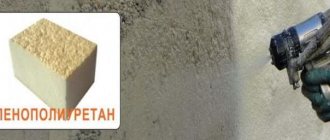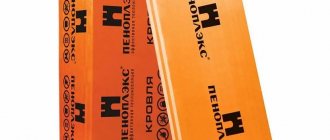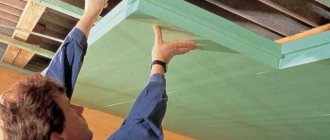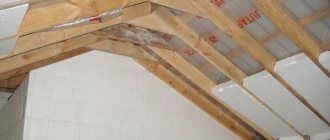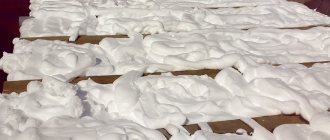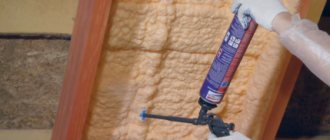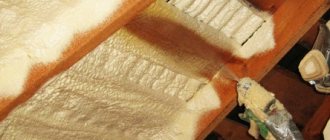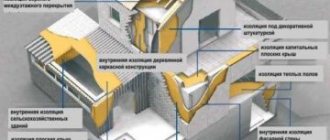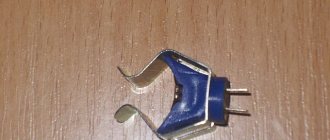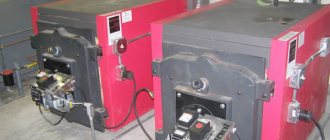Features of the technology
Polyurethane foam is obtained by mixing a polyol and a diisocyanate. Individually, these components are quite toxic, but during a chemical reaction they lose their harmful properties. During the production process, a large volume of carbon dioxide is released, the bubbles of which are enveloped in a thin polyurethane foam shell. The resulting mass is applied to the surface using a special gun, and in air it foams and hardens.
Polyurethane foam is divided into two main types:
- Lightweight open cell . Its characteristics are similar to mineral wool, but it costs more. When applying it, it is necessary to use vapor and waterproofing films.
- Closed cell with different density levels . Polyurethane foam with low density (up to 32 kg/m3) is used for internal insulation of walls and ceilings, with medium density (up to 40 kg/m3) - for filling cavities, with high density (up to 80 kg/m3) - for treating surfaces that will be exposed to severe mechanical stress.
The application technology is not complicated, but the process uses hazardous components and expensive equipment. Therefore, it is better not to take risks and entrust this task to professionals.
Scope of application
Polyurethane foam, no matter what type it has, can be applied by one single method - spraying. The main feature of any liquid insulation, and polyurethane foam in particular, is the quick completion of all operations. If we compare it with slab and roll insulation, we can say that polyurethane foam does not take any time at all. It does not require additional effort associated with installing a supporting frame or gluing insulation.
Thermal insulation of one-story and multi-story buildings
Polyurethane foam can be used to insulate any structure: frame, brick, block, panel, wood. The main thing is that they do not experience serious mechanical stress. It can be used to insulate internal and external walls of facades.
IMPORTANT! If the façade is thermally insulated, it is made of wood, brick or concrete, then it is necessary to create an additional frame for the cladding. You can attach a facade panel or other similar facing material to it.
It is important that polyurethane adheres well to the surface. This is very important, especially if there are inclined elements.
Due to this property, polyurethane insulation is very often used on the roofs of houses, especially when the attic floor of the attic is being installed.
Thermal insulation of industrial and technical objects
The method of applying insulation is one of its main advantages. Spraying a layer of insulation is much more convenient than fixing or laying it. This is especially true for buildings and structures that have large shapes and sizes.
The material is often used to cover the internal walls of industrial refrigeration rooms, in which it is necessary to maintain high temperatures. The lower limit for the use of polyurethane foam is 130 degrees Celsius.
Polyurethane foam is a material that does not have any restrictions on its use. It can be used to insulate joist floors, but with the condition that the heat-insulating layer will be located between the beams without experiencing compressive loads.
Thermal insulation of pipes
Polyurethane foam is also used in technical lines - pipes suitable for moving various liquids, gases and vapors. Insulating pipes with this material is a quick and high-quality solution to the problem, while simultaneously saving space for any object that needs insulation.
Many pipes, ventilation shafts and elements of production lines are insulated with polyurethane foam, which is the main element. This material can withstand severe temperature changes. The main limitation is the ability to apply to large diameter pipes.
The material has a rigid shape, so it can fill any cavity. Today, polyurethane foam is the only insulation used to create a thermal insulation layer in the internal space of hollow concrete and brick walls while maintaining the integrity of their structure.
Thermal insulation of frame houses
Today, insulating a frame house with polyurethane foam is the choice of most construction organizations, as evidenced by reviews from many users. The wall of many frame houses consists of wood formwork, which is filled with insulation. The use of this technology allows you to quickly build a comfortable home.
In addition, during the construction of frame houses, the outer walls are insulated. This allows you to significantly speed up the process and obtain high-quality thermal insulation that will last for many years, retaining heat.
Advantages of polyurethane foam insulation
- High-quality heat and noise insulation - thanks to the porous structure of the material.
- The absence of joints and seams means a minimal likelihood of “cold bridges” appearing.
- Fluidity - can be applied to surfaces of any shape.
- Versatility - adhesion to almost any material (except polyethylene).
- Long service life - thermal insulation properties begin to decline only after 25 years.
- Self-extinguishing - PU foam does not support combustion.
- Quick work - applying polyurethane foam does not require serious preparation.
- Low hygroscopicity of the finished layer - additional waterproofing is required only when insulating with open-cell polyurethane foam.
Is it possible to insulate an attic with polyurethane foam?
The presence of an attic already indicates that it requires insulation. It's stupid to have a second floor and not use it to expand your living space. Even if you are not supposed to live in these rooms in winter, you still cannot do without this procedure. Heat from the lower floor tends upward. If the roof is not insulated, condensation will form when it encounters cold air. The attic will always be damp, fungus will appear, and the wooden elements of the rafters will quickly rot.
The properties of polyurethane foam determine the material as an excellent insulation material for the attic.
Regarding polyurethane foam, we can say that this is ordinary polyurethane foam, only for such work it is used in large volumes. For the attic, polyurethane foam is considered an excellent choice. The material, when frozen, forms many sealed pores with air, thereby improving its insulating properties. Hardened polyurethane foam does not allow steam and moisture to pass through. It does not need steam or waterproofing. Due to expansion, polyurethane foam fills all hard-to-reach areas. Foam insulation is considered safe, since the material is environmentally friendly and does not tend to support combustion. All of the above qualities meet the requirements for attic insulation. It is safe to say that polyurethane foam is suitable for the job.
A special feature of the attic is the complex shape of the roof. The use of rigid slabs in some areas is not possible. Rolled materials slide off the slopes, and the mineral wool cakes. A popular insulation option is to lay basalt slabs, but they need to be protected on both sides with membranes from moisture. With polyurethane foam everything is simple. Spray foam onto surfaces of any complexity. Even on breaks in the roof, a solid sealed layer is formed.
Important! If the insulation is done with polyurethane foam, the attic stops “breathing”. The effect of a thermos is created. Ventilation will be required, otherwise dampness will form. 1-2 layers of polyurethane foam on the attic roof can save up to 30% of heat
In a non-residential attic, it is enough to spray a couple of layers of polyurethane foam, which will already save up to 30% of heat. However, it is important to know that UV rays degrade foam. After insulation, you will definitely have to attach the finishing sheathing, for example, lining.
Another nuance is the choice of insulation technology. There are three types of polyurethane foam. Foam varies in hardness: soft, medium and high. Classic insulation technology is based on the use of polyurethane foam of the same hardness. Polyurethane foam is sprayed in several layers. In complex technology, several types of foam are used, only the layers are sprayed alternately. For the first layer, hard polyurethane foam is always used. Its thickness ranges from 3 to 5 cm. Subsequent layers are sprayed with soft foam. Their thickness varies from 5 to 8 cm.
Disadvantages of polyurethane foam insulation
- Compliance with technology directly affects the quality of insulation and the service life of the finished coating. Therefore, work should be carried out by experienced craftsmen using high-quality components and certified equipment.
- Polyurethane foam does not burn in the direct sense of the word, but during a fire the material emits very acrid smoke. This can be dangerous to health and even life.
- Under the influence of ultraviolet light, the hardened foam changes color - from white it becomes dark brown.
- The cost of the service can be quite high. The lowest price per m2 is for lightweight open-cell polyurethane foam, but it cannot be used in all cases.
Manufacturers and prices
Experts call the following companies the best producers of polyurethane foam:
BASF Polyurethanes GmbH. The German company is a leader in the production of polyurethanes. The product line also includes polyurethane foam. In Russia, together with OJSC Nizhnekamskneftekhim, they created the Elastokam enterprise to produce components for polyurethane foam.
Yantai Wanhua Polyurethanes Co., Ltd. Chinese manufacturer with a high-quality line of polyurethane foams.
SYNTHESIA INTERNACIONAL SLU The Spanish chemical company SYNTHESIA INTERNACIONAL SLU has been producing polyurethane foam since 2008. The products have found their buyers in many countries around the world, including Russia.
The price from all manufacturers is about $650 per 1 m3.
Comparative characteristics
The properties of polyurethane foam are most clearly visible in comparison with similar thermal insulation materials:
| PPU | Mineral wool | Foam concrete | |
| Standard material density, kg/m3 | 28-160 | 15-150 | 250-400 |
| Recommended thickness, mm | 50 | 90-100 | 760 |
| Thermal conductivity coefficient, W/m*K | 0,019-0,040 | 0,052-0,058 | 0,145-0,160 |
| Operating temperature limits in degrees Celsius | -200… +150 | -40…+120 | -30…+120 |
| Declared service life | 25 | 5 | 10 |
Rules for pouring liquid foam
In order for penoizol to fully live up to the hopes placed on it, it is necessary to strictly adhere to the pouring technology. If this is your first time dealing with liquid thermal insulation, it is better to immediately contact specialists who can do the job efficiently.
Wall insulation is carried out according to the following scheme:
- Holes are drilled in the wall structures, into which penoizol is pumped through filling hoses.
- Install a protective facade made of metal profiles, leaving a gap of 5-10 cm between the wall and the metal.
- Fill the free space with insulation.
- Wait 4 hours for the material to set, cut off excess insulation, and begin finishing.
Roof insulation:
- The surface intended for insulation is covered with a film, which should extend 10-15 cm .
- Fix the membrane with staples.
- The slats are stuffed on top of the film.
- The space between the slats is filled with insulation.
- Wait 15-20 minutes for the insulation to become viscous and level the surface.
- After 4 hours, you can begin further work.
Floor insulation:
- Wooden sheathing is being installed.
- All sections are filled with insulation.
- When the material hardens, a plastic film is placed on top.
- Finishing is carried out: boards are laid or concrete is poured.
In principle, working with penoizol is practically no different from installing other types of insulation.
Owner reviews
“I have heard complaints several times that home owners have headaches after insulating them with polyurethane foam. And the smell of the material is not pleasant. These moments are entirely the responsibility of the company that carried out the work. Here it is important to follow the technology and the exact proportions of mixing the components, then there will be no problems.” Victor
“I decided not to deal with complex roofing “pies” and ordered polyurethane foam insulation. The roof and walls of the attic were insulated, and the remainder was used for the garage. Two winters have passed - I am very pleased! Warm, comfortable, no smell. True, I had to tinker with finding craftsmen. Not everyone takes on this kind of work.” Arkady
“After insulation, they forgot to turn on the batteries. We noticed when it got cold outside to 0 degrees. In my opinion, this speaks volumes about quality." Inna
What kind of thermal insulation material is this?
Let's start with definitions. The name "Penoizol" is a trademark of insulation created on the basis of urea resins. The material is in high demand, so it has become a household name, combining the following names:
- "Teploizol"
- "Mipora"
- "Unipor"
- "Mettemplast"
However, among professional builders, insulation is better known as liquid or poured foam.
In appearance, thermal insulation resembles marshmallows, which, after hardening, turns into an elastic mass that is guaranteed to fill all voids.
The composition of the insulation includes the following components:
- Urea resin
- Orthophosphoric acid
- Foaming additives
The ingredients are mixed in certain proportions and pumped into special cylinders where the mixture is under pressure.
